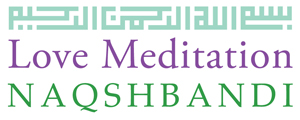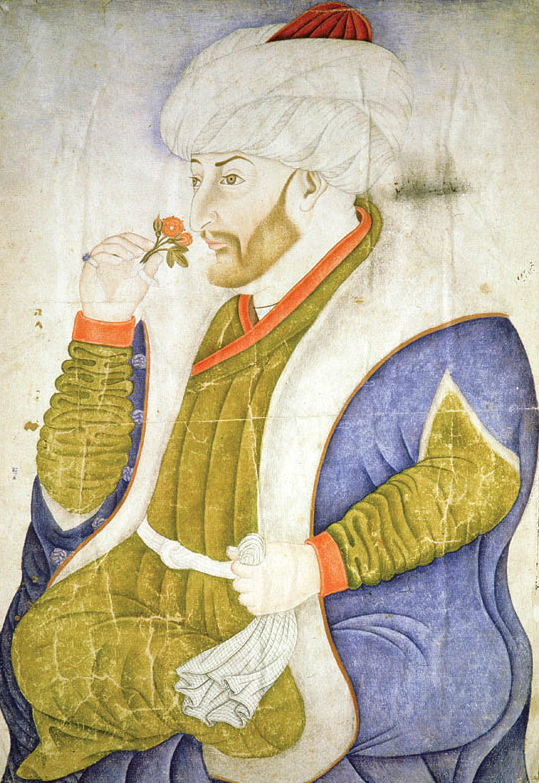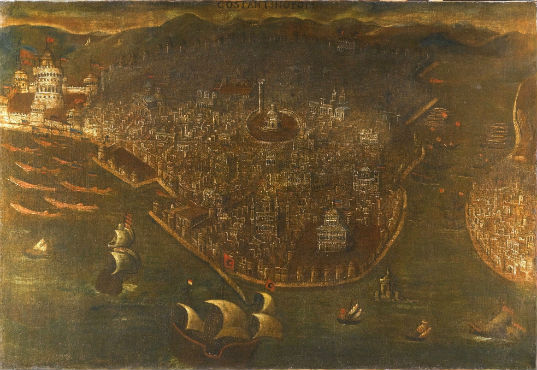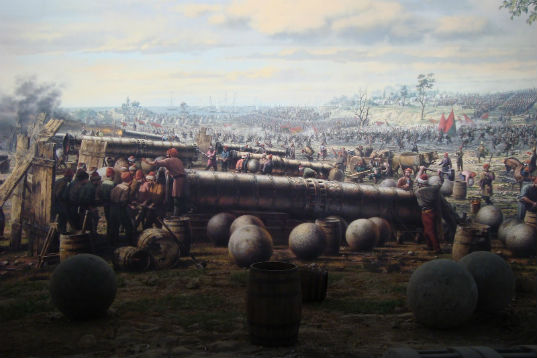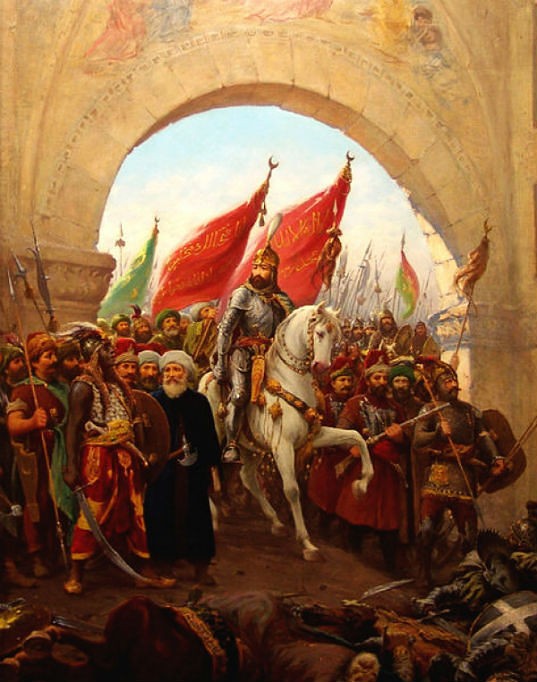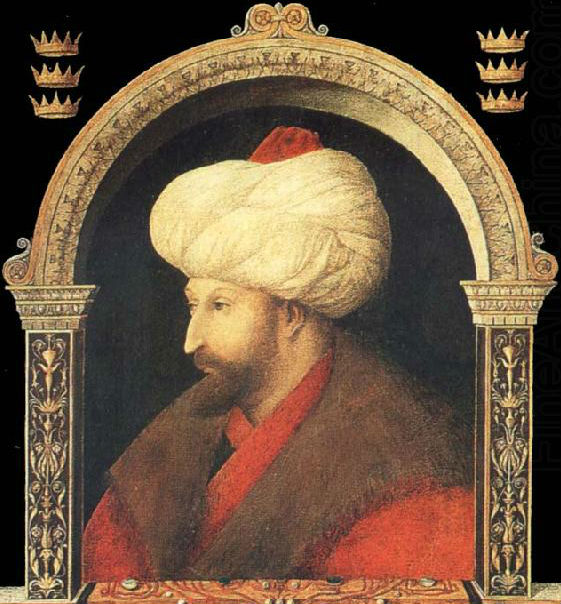Sultan Mehmed II, Conquest of Constantinople (Islambol – Istanbul) – 20th Jumada – 6th Feb 2018
Sultan Mehmed II, Conquest of Constantinople, anniversary 20th Jumada (6th February 2018)
Sultan Mehmed II (RA), conqueror of Constantinople to become Islambol and then later Istanbul. (Islambol (lots of Islam) or Islambul (find Islam), both in Turkish Language, were folk-etymological adaptations of Istanbul created after the Ottoman conquest of 1453 to express the city’s new role as the capital of the Islamic Ottoman Empire.)
The capital of the Eastern Roman Empire, Constantinople was conquered by the Ottoman Army, under the command Ottoman Sultan Mehmed II on 29th May 1453 (20th Jumada I 857 AH). With this conquest Ottomans became an Empire and one of the most powerful empires, The Eastern Roman Empire fell and lasted. After the Constantinople conquest, 21 years old Ottoman Sultan II. Mehmed also took the title “The Conqueror” added to his name.
Although his early age of 21, Sultan II Mehmed (RA), started to prepare siege for İstanbul. He wanted to be the commander as Prophet Hz Muhammed (SWS) mentioned the conqueror of Constantinople; “One day, Constantinople will be conquered. How wonderful and blessed are the commander of its conquest and his soldiers!” decades ago. First he took precautions with strategic tactics in both inside and outside of the state. After this, he moved to conquer Constantinople.
CONQUEST PREPARATIONS
Sultan Mehmed II built a second Ottoman fortress, called Rumeli Hisari on the Bosphorus in 1452. Rumeli Hisarı is set directly across the strait from the similar fortress Anadolu Hisarı, his great grandfather Sultan Bayezid I had previously built on the Asian side. This movement gained for the Ottomans complete control of sea traffic on the Bosphorus and set the front of Eastern Roman Empire sea traffic especially with the Genoese colonies on the Black Sea.
Constantinople had been attacked in the past many times, but its great walls always prevailed. Sultan Mehmed II (RA) planned and drew troops for the city walls and commanded preparation of them to the talented Mr. Hungarian Orban and he created like a supergun for Ottomans. Sultan Mehmed II (RA) planned to attack the Theodosian Walls, a series of walls which protected an attack from the West and the only place not surrounded by water. Ottoman naval had prepared too.
After all politics and strategic preparations, the Ottoman Army moved from Edirne to take the Constantinople in 23 March 1453.
CONQUEST OF CONSTANTINOPLE
Constantinople had been an imperial for many years. The city were bombarded by the infamous bronze cannon fires which was designed by Sultan Mehmed II (RA) the Second himself and made by Orban and his foundry in Edirne. Constantinople had been attacked in the past many times, but its great walls always prevailed. Sultan Mehmed II (RA) changed this with the use of Orban’s bronze cannons forever. Sultan’s massive cannons (over 69 were made, each over 27ft long with diameter of 30 inches for each shot) transported over 140 miles by 200 hundred and over 60 oxen over hills and land! Each shot weighed between 200-1500 pounds each. The power and intensity of the cannons made the whole area around each cannon to tremble the land and ferocious fire emitting each time a shot was fired!
Firing 120 shots a day, by May 28, the guns had been firing continuously for 47 days, expending 55,000 pounds of gunpowder and delivering an estimated 5,000 shots. Gunners had blasted nine substantial holes in the outer wall, only to be replaced piecemeal by the earth stockade.
Baltaoglu Suleyman Bey launched the first attack to enter the Golden Horn gulf on 9th April 1453 and failed to break the chains which was placed at the mouth of the horn. This chain, which floated on wooden logs, was strong enough to prevent any Ottoman ship from entering Golden Horn. The victory of the Pope’s Christian and Genoese ships decreased the morale of the Ottoman army.
During this chaos and widespread feeling of lose, with the Sultan’s spiritual menthor Aksemseddin promised certain success about the conquest. Sultan Mehmed II (RA) improved the new type of cannon as called as “humbara”, today known as “howitzer” which is taken an aim for shooting the target. It is an important discovery for the world’s army history. Cannons were not enough to take the city. Encouraged by spiritual support, Sultan Mehmed II (RA), decided plan for his navy. the Ottoman fleet anchored in Dolmabahce would be moved to the Golden Horn gulf by land as an element of surprise. Several ships and galleys carried by soldiers via rope were slid over slipways. In the morning of 22th April, Eastern Roman Empire woke up with a surprise and terrified when they saw Ottoman galleys in the horn.
On 29th May, the Ottoman army attacked for the final assault. The siege lasted from Friday, 6 April 1453 until 29 May 1453, 57 days, Tuesday when the city was conquered by the Ottomans under the command of Sultan Mehmed II (RA). A new era started on the world and a new balance came through by the conquest of Constantinople.
AFTER THE CONQUEST
Sultan Mehmed II (RA) the Conqueror, started the process of rebuilding in Istanbul after the conquest of Constantinople. Fatih Sultan Mehmed II (RA), rearranged the city without damaging the fabric of Istanbul with his unique knowledge upon western culture.
According to the Halil İnalcık’s “Rebuilding of Istanbul By Fatih” article, Sultan Mehmed’s II (RA) priority was reconstruction of Constantinople: “During the whole of his reign the Conqueror’s preoccupation was to make Istanbul a true metropolis of his empire” written in Halil İnalcık’s “Rebuilding of Istanbul By Fatih”article. According to the article some of the developments after the conquest are: “Before the Conquest, Istanbul was but a dead city. Mehmed the Conqueror strove with great energ’y to make it again into the political and economic centre of an empire; to this end he took measures for the speedy repeopling of the City, as well as for its reconstuction…
Before Istanbul’s conquest by the Ottoman Turks, contemporary writers (e.g. Clavijo) pointed out the ruinous state of Ayasofya. The very first act of the Conqueror was to have the famous temple restored. To its repair and to the salaries of those employed in it he allocated extensive pious foundations…
Following in the footsteps of the Sultan, the Viziers and notables created by way of pious foundations establishments in section after section of the City, and these in turn developed into new districts, contributing to a rapid extension and repopulation of the City. These establishments generally included, as in the case of the Mahmud Pasha Foundations, a mosque, a madrese and an imaret, to which were added caravanserais and shops. The Mahmud Pasa Bazaar, composed of 260 shops, had expanded into one of the liveliest trading centres of the whole City. The Mahmud Paga Complex was completed in 1462. Thus Istanbul, in the Conqueror’s very lifetime, became covered with palaces, hostels, caravanserais, bazaars, hans, baths, colleges and assumed the aspect of a flourishing, active Turkish city.”
MEHMED THE CONQUEROR
Sultan Mehmed II (RA), also known as The Conqueror is one of the famous sultans of Ottoman Empire known for his intelligence and wisdom. Sultan Mehmed II (RA) ruled the Ottoman for a brief time, from 1444 to 1446, after his father. After that time Sultan Murad II (RA) renounced the throne but when he died Mehmed II (RA) ruled the Ottoman Empire from 1451 to 1481. Sultan Mehmet II (RA) was a genius statesman and a military leader who was also interested in literature, fine arts and monumental architecture. He was educated by famous scholar Aksemseddin and according to Ottoman historians he was speaking seven languages fluently. (Portrait below by Bellini – National Gallery, London)
Sultan Mehmed II (RA) was born as a son of Sultan Murad I and Huma Hatun (RA) on the night of 29th binded to 30th March 1432, in Edirne. His early childhood passed on Edirne for a while. He was motivated for taking the city of Constantinople by Holy Prophet Muhammed’s (SWS) (Hadith-al-Bukhari RA)) words for the conqueror of Constantinople decades ago; “One day, Constantinople will be conquered. How wonderful and blessed are the commander of its conquest and his soldiers!” Sultan Mehmed II, overthrew the Byzantine Empire by conquering Constantinople as consolidating the Ottoman Empire and marking the end of the Middle Ages. He took the name “Conqueror” (Fatih) after the conquest of Istanbul on 29th May 1453 (20th Jumada I 857 AH). The conquest of Istanbul spelled the end of the Byzantine Empire and entered a phase of urban revival under the wise and tolerant administrations of Mehmed and his immediate successors.
The capture of Istanbul was followed by a long succession of campaigns which resulted in a tremendous extension of direct Ottoman rule. After the conquest of the city, Mehmed II (RA) the Conqueror marched towards Morea and captured the cities of Greece one after another. However, he was threatened from the rear by the principality of Karaman and therefore turned to Anatolia to vanquish them and to annex their territory. He then conquered the area close to western Black Sea and appointed as governor Kızıl Ahmet who was the founder of the principality Isfen-diyar. Afterwards, he fought Uzun Hasan, the ruler of the Akkoyunlus and overcame him.Among those areas that fell to Sultan Mehmet II were Serbia, Greece, the Empire of Trezibizond, Wallachia, Bosnia, Karaman, Albania and several Venetian and Geneose maritime establishments.
Sultan Mehmed II (RA) 2nd’s wife’s were Gulbahar Hatun, Gulshah Hatun, Sitti Mukrime Hatun, Cicek Hatun, Helene Hatun, Anna Hatun and Alexias Hatun. He had a daughter named Gevrehan Sultana and sons; Mustafa, Bayezid II (Sultan after Mehmed II), Cem and Korkut. Mehmed II was dressed in the simple and heroic manner of his great grandfather Çelebi Mehmed. His turban consisted of a ”Mücevveze” (a tall cylindrical headgear) in military style, wound round with coiled gauze. This special type of turban became fashionable among later sultans.
The Codes of Sultan Mehmed II (RA) was a very important document for his era. It was a constitution ordering the state men duties and legalizing the fratricide for the order of the empire. This code included establishing various organizational positions, produce a form of law that suited the growing empire’s geography and state organizations after the conquest of Constantinople.
Sultan Mehmed II (RA) ruled the Ottoman Empire for 30 years and joined 25 campaigns himself. He was a very strict statesman and a very brave soldier. The great emperor had died on 3rd May 1481 (4 Rabi al-Awal 886 AH) and he was buried in “Fatih Turbesi” (tomb), near the Mosque of Fatih in Istanbul. After the Sultan’s death, the Ottoman Empire remained culturally and geographically strong as long as they were both supported by Divine orders until the last 34th Ottoman Sultan, the last Sultan, Sultan Abdul Hamid II (RA).
May Allah Almighty (God) bring the new Ottoman Divine order back again Inshallah!
For Fatih Sultan Mehmed II – Bir hurmati habib bir hurmati anzalta Surat al-Fatiha!
